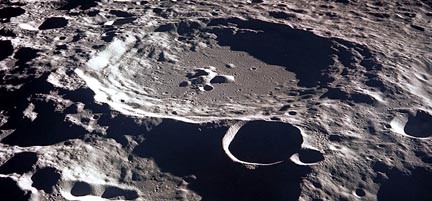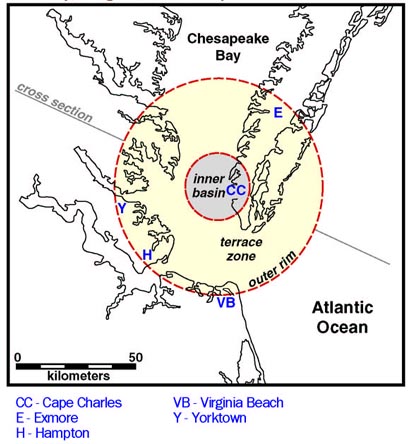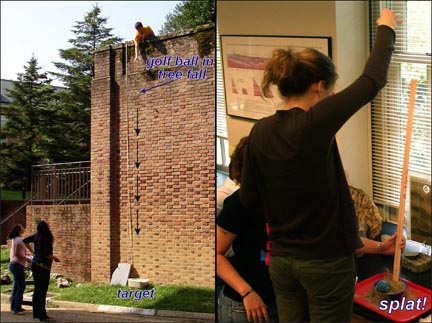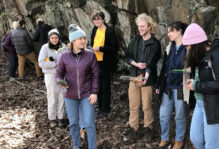Making an Impact
The Earth’s moon is pockmarked with craters. But just how did those craters form? The origin of lunar craters was debated from the mid-17th century well into the 20th century, with many astronomers favoring a volcanic origin while a number of geologists explained them as the result of impacts from the collision of extra-lunar bodies with the moon. World War I brought an appreciation of craters formed by explosions and scientists noted high velocity meteoroid impacts would produce similar results. By the late 1940’s the impact origin for lunar craters had carried the day and the age of space exploration made it clear that impact craters are common on most rocky bodies throughout the Solar System.

Oblique aerial view (from Apollo 11 mission) of impact craters on the Moon.
The recognition and acceptance of impact cratering on Earth took even longer. The Earth’s active surface and tectonic processes conspire to destroy or hide many craters. Today over 150 impact craters are recognized on Earth and the role that these impact events have played in Earth’s history is significant. William & Mary lies just beyond the outer rim of the Chesapeake Bay impact structure. Glance at a map of southeastern Virginia and you’ll see no clues of the largest impact crater in the United States. This 85-km wide crater was first recognized in the 1990’s based on deep coreholes and seismic profiles of the subsurface. As an undergraduate at W&M in the late 1980’s I learned that Virginia’s Coastal Plain forms a wedge of sediment that becomes progressively thicker towards the Atlantic Ocean. When I joined the faculty in 1996 the geology of the Coastal Plain had dramatically changed, a huge crater had disrupted our understanding of the Virginia Coastal Plain. Ah, the march of scientific discoveries and progress.

Simplified map of the Chesapeake Bay impact crater.
The reason that the Chesapeake Bay impact crater went unrecognized for so long is that it is buried beneath a blanket of younger sediments that filled the crater in and over. During the last 10 years a number of deep drill cores have penetrated the structure and geologists have learned much. The crater formed 35 million years ago when a hurling mass struck the shallow ocean off the coast of what is today Virginia. As Ammie Pascua (W&M ’07) persuasively opined on the Geology of Virginia website “it’s a crater-ghost screaming out from its watery grave to be understood and celebrated” (http://web.wm.edu/geology/virginia/whats_new/CBIS.php). I can’t argue with that.
So just how large was the impactor that smacked into Ol’ Virginny creating the Chesapeake crater? That is the question I put to my Planetary Geology class. We took a simple experimental approach. We made our own impact craters by dropping golf balls, gum balls, clay balls, and lead balls into a target of dry sand.

Planetary Geology class making impact craters.
As the kinetic energy of the impactor increased so did the size of the crater. Plotted on a log-log graph, the data falls nicely onto a line (many things look better in log-log space!). So it should be a simple matter to scale these data up to determine the kinetic energy needed to produce a crater the size of the Chesapeake crater. Our experimental impactors had a maximum kinetic energy of ~60 joules, based on our data approximately 1021 joules are required to do the job. That is quite a bit of scaling, but what’s 20 orders of magnitude among friends?

The Planetary Geology class dataset (note the logarithmic scales).
Delightful, 1021 joules is clearly huge (the first atomic bombs packed a punch of about 1013 joules). So how does that get us closer to knowing the size of the Chesapeake impactor? Kinetic energy is directly related to the mass and velocity of an object (1/2 m v2). With knowledge of the impactor’s kinetic energy and an estimate of its velocity (meteors have been clocked at 10 to 30 km per second when they collide with earth) we can determine the mass of the impactor. From there we have only to do the mathematical gymnastics of manipulating mass and density to find the volume and ultimately the diameter of the impactor. Great fun, eh? My estimate is 2 km ± 1 km.

Frenetic or frantic? Claire Still (’09) calculating the diameter of the Chesapeake Bay impactor.
Our approach is fraught with difficulties. Firstly, our experimental impactors were traveling at very slow velocities, it’d be much better to have employed, say, NASA’s Vertical Gun Range to accelerate our impactors to speeds of kilometers per second. The strength of the target plays a role and we ran loose and fast with our scaling laws. But there is value in making the estimate nonetheless. The Chesapeake Bay crater is intriguing and a number of researchers are working to answer questions about the impactor and the dynamics of the crater’s formation using sophisticated hydrodynamic numerical modeling. It is cool stuff.
For further reading:
Collins, G. S. and Wunnemann, K., 2005, How big was the Chesapeake Bay impact? Insight from numerical modeling: Geology, v. 33, p. 925-929. See their animations at the GSA Data Repository- item# 2005183 (http://www.geosociety.org/pubs/ft2005.htm)
Crawford, D. A. and Barnouin-Jha, O. S., 2004, Computational Investigations of the Chesapeake Bay impact structure: Lunar and Planetary Science XXXV, 1757.pdf
Melosh, H. J., 1989, Impact cratering: a geologic process: Oxford University Press, 245 p.




No comments.
Comments are currently closed. Comments are closed on all posts older than one year, and for those in our archive.